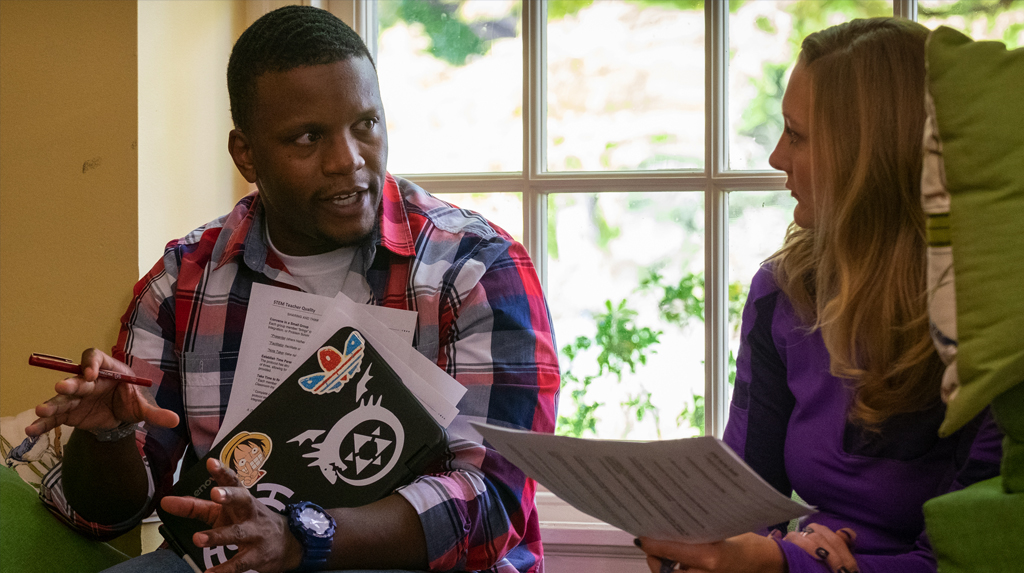Diversity and Equity
Collaborative Leverages Business and Community Resources for Transformative Approach to STEM Education
By 2022, employment in the STEM fields (science, technology, engineering, and math) in the St. Louis region is projected to grow by 12.4%, according to the most recent State of St. Louis Workforce report focused on STEM. But St. Louis employers are struggling to fill these positions. In 2018, 41% of St. Louis companies cited a shortage of workers with knowledge and skills as the primary barrier to expanding employment (St. Louis Community College 2018; see Figure 1). This workforce gap in the St. Louis area isn’t an isolated situation, but it is against this backdrop that a unique STEM pipeline collaborative took shape, with the vision to tackle the workforce shortage and income inequity by inspiring students to pursue STEM careers.
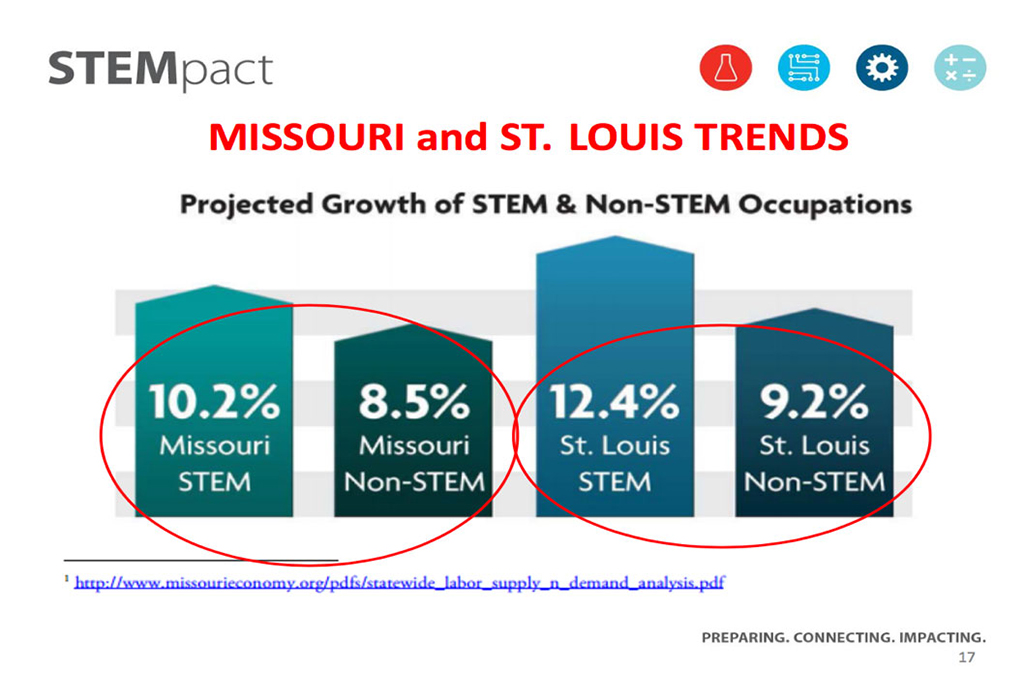
Strengthening STEM education through collaboration
A dialogue was sparked in 2010 among St. Louis–area corporate leaders, spearheaded by Deborah Patterson, then president of Monsanto Fund, the philanthropic arm of Monsanto Company (now operating as Bayer), about the need to attract STEM talent to the St. Louis region (see Figure 2). The group spent two years studying the problem. Their starting point was to perform a needs assessment and focus group research. They surveyed K–12 educators, university faculty, informal education providers, and corporate stakeholders before identifying teacher training as the critical piece to improving STEM education in the region.
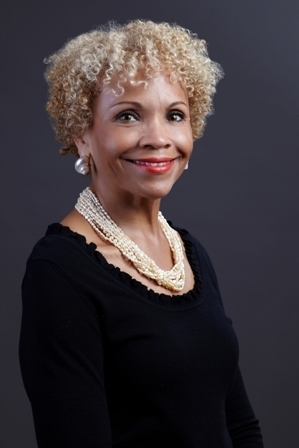
Determining that money alone could not solve the problem, and that talent is pivotal to a successful business, the companies decided to pool their resources and invite representatives from universities, schools, and informal institutions (e.g., YMCA, YWCA, Girls Inc., Boys and Girls Club, Saint Louis Science Center) to one planning table. Ultimately, that early dialogue and research led to the formation of STEMpact, a collaboration of St. Louis’ top STEM employers, local foundations, a team of STEM instructors from across formal and informal settings, and Washington University in St. Louis (WashU). This novel approach combined resources to invest in strategic professional learning programs for educators, targeting K–8 STEM educators from both in-school and out-of-school settings. In addition to science and STEM teachers, participants include leaders of afterschool programs, as well as music and art teachers, librarians, and physical education instructors.
The overarching mission of STEMpact is to provide all students access to high-quality STEM education. The initiative recognizes that those early years are important to fostering critical thinking and problem-solving skills. Students decide early in their educational journey if they are capable in STEM fields or not. Research shows that middle school students exposed to STEM activities and the nature of STEM work have a higher likelihood of pursuing STEM careers (Blotnicky et al. 2018). We have all met people who self-label as a “math person,” “science person,” or “reading and writing person.” STEMpact believes teachers and afterschool educators are in the best position to inspire and prepare students with the STEM confidence and critical-thinking skills they will need to be successful in a world where STEM skills are essential. STEMpact does not just support formal STEM teachers; Participants include leaders of afterschool programs, as well as music and art teachers, librarians, and physical education instructors.
Founding funding members of STEMpact include Boeing, Monsanto (now Bayer), Emerson, Sigma-Aldrich (now MilliporeSigma), Express Scripts, and WashU. The collaborative has grown to include individuals and foundations, such as the James S. McDonnell Family Foundation. The participation of each partner has been crucial to the success of the collaboration. With educators to identify the problems in current STEM education models, higher education to provide cutting-edge research, and corporate leaders to forecast the needs of tomorrow’s workforce, STEMpact has the ability to formulate best practices that encompass both present and future needs.
One funder said of STEMpact, “It’s about the development of long-term talent that is critical to our business. A partnership with STEMpact is strategic philanthropy for the future of the business.” Another funder said, “It is a regional commitment to a diverse pipeline for future careers.”
Early in her discussions with corporate leaders, Patterson tapped the expertise of Victoria May, executive director of the Institute for School Partnership (ISP) at WashU. Since its inception in the 1980s, the ISP has been at the center of redefining STEM education in the region, connecting the resources of WashU with the local K–12 community. The ISP is notable in the region for its ability to offer comprehensive, multilevel support to teachers, school leaders, and districts. In 2016, STEMpact became a WashU program managed by the ISP, and May became STEMpact’s executive director.
At present, Missouri (and the rest of the United States; see Figure 3) has significant gaps in proficiency in STEM subjects corresponding to race, ethnicity, and gender, likely the result of uneven access to high-quality STEM learning opportunities. This equity issue was foremost in the minds of ISP educators who created STEMpact’s groundbreaking professional learning programs.
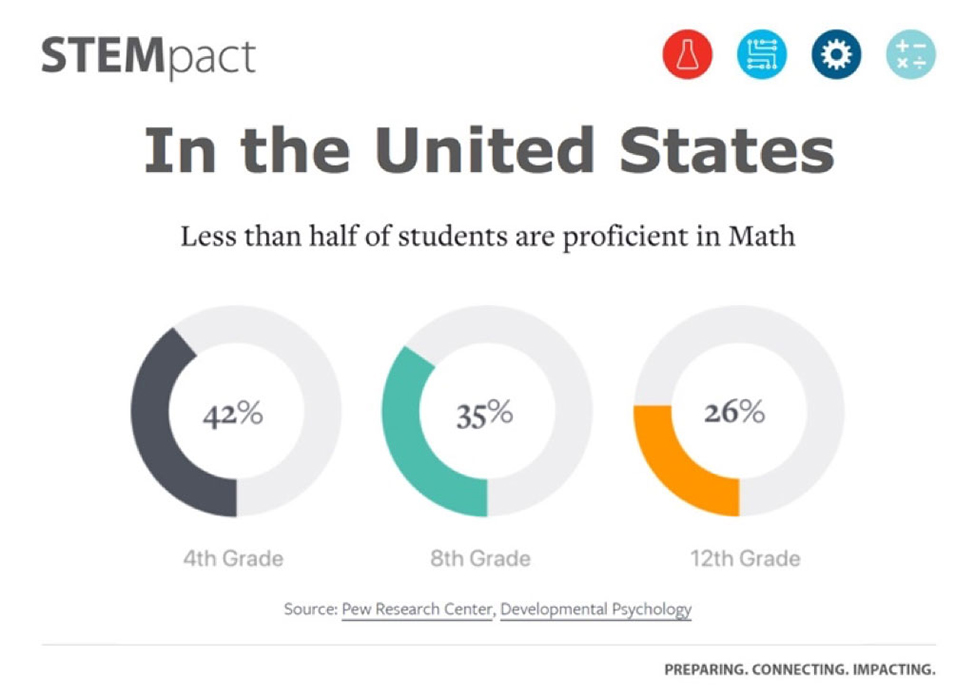
The debut programs targeted classroom teachers and afterschool educators. These programs are unique in that they focus on offering long-term professional learning opportunities and support to the adults tasked with preparing our kids for the future.
STEMpact has four core professional learning programs: STEM Teacher Quality (STEM TQ), STEMpact Integration Quality (STEM IQ), STEMpact Leadership Series, and STEMpact District Immersion. The programs are:
- long-range: setting in place a new mindset for STEM education.
- forward-thinking: prioritizing equitable and inclusive STEM education throughout our region.
- collaborative: bringing educators together for shared learning and planning.
- responsive: embracing educators and business community input to modify and develop programs aligned with changing needs.
STEM TQ: Teacher preparation is key to developing STEM-literate students
The initial program offering was specifically designed for K–8 educators who teach STEM or want to integrate STEM into their curriculum. This audience has also included instructional specialists from informal science institutions such as the Saint Louis Science Center, Saint Louis Zoo, and the Gateway Region YMCA.
The STEM Teacher Quality Institute (STEM TQ) is a 100-hour, yearlong professional learning endeavor involving teams of teachers from St. Louis regional school districts (Missouri and Illinois). It seeks to enroll 75% of attendees from those serving in areas of high need. The program starts with a two-week summer institute that is held on the WashU campus. The institute is followed by monthly meetings throughout the year. Between September and April, participants take part in six afterschool sessions. Three full-day, follow-up sessions occur in October, January, and March. The afterschool sessions are focused on the implementation of STEM lesson plans at school sites, whereas the full-day sessions are STEM integration professional development opportunities with an informal science partner institution, such as the Missouri Botanical Garden, Challenger Learning Center St. Louis, and MADE makerspace.
There is no set registration or materials fee to take part in the STEM TQ program. STEMpact will cover all expenses. The yearlong program costs $3,200 per educator, which includes stipends and a computer for each participant.
Participants are eligible to receive a $1,000 stipend (10 days × $100 = $1,000) for attending the summer institute, and $50 each for the six afterschool sessions (6 × $50 = $300). Districts must cover the costs of substitutes for the three full-day follow-ups. The sessions are scheduled in multiple locations to accommodate the geographic distances of participating districts.
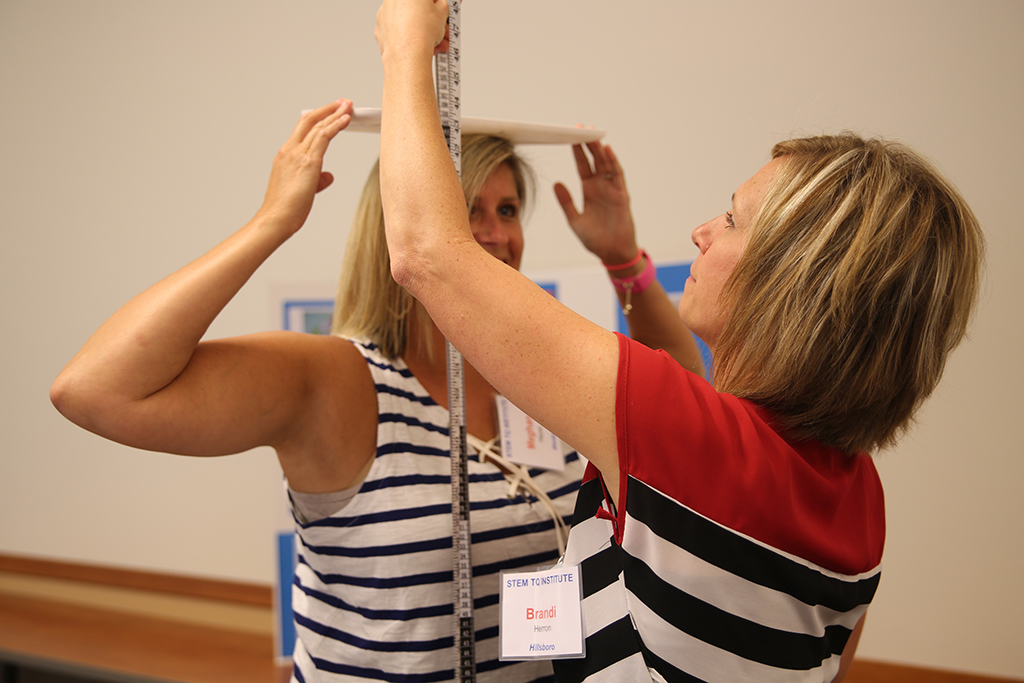
The goal is to teach educators how to integrate STEM curriculum into everyday teaching methods through a process we call “STEMitizing” (see Figure 4). The program wants teachers to see that STEM is everywhere, and to see themselves as STEM-capable educators and their students as STEM-capable learners. A main tenet of the STEMpact strategy is to show teachers how to “STEMitize” their classrooms—that is, to find and relate STEM concepts across subjects.
As previously stated, STEM TQ begins with a two-week summer institute on WashU’s campus. A key part of the institute is field trips, each focusing on a different industry with different needs (see Figure 5). During these outings, teachers experience STEM-to-career connections that they can pass on to students. Institute facilitators are individuals with experience in higher education, with K–12 teachers, and with administrators and those who have a background in community and nonprofit settings.
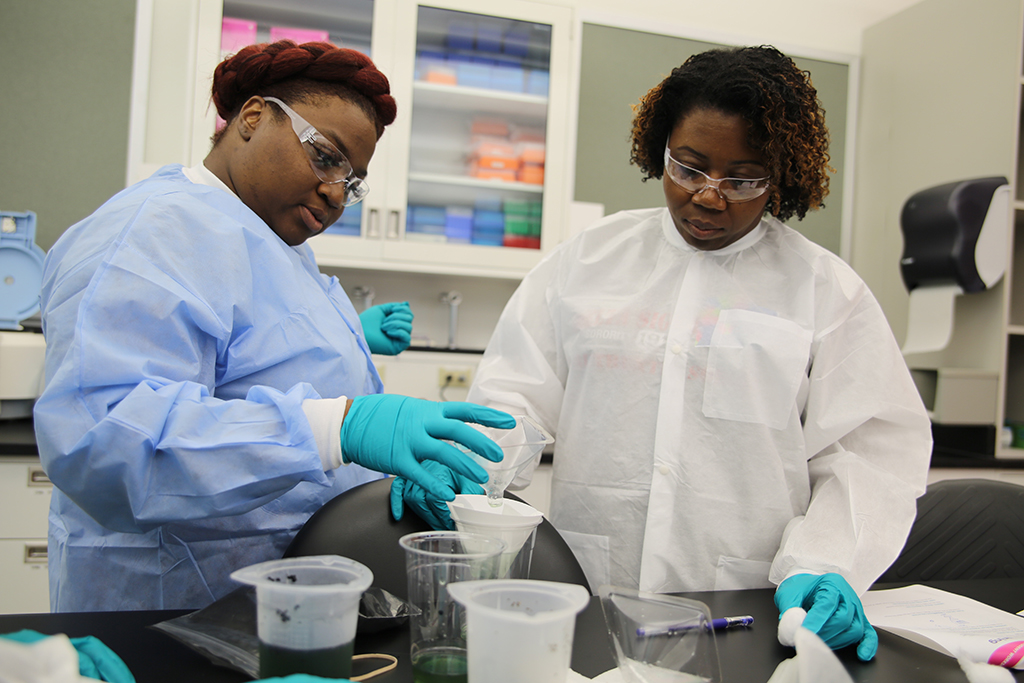
On one field trip, teachers tour MilliporeSigma and then conduct a water quality experiment in a lab run by MilliporeSigma scientists. Another trip takes teachers to Castlewood State Park, where they engage with conservationists and learn about healthy streams and bank erosion (see Figure 6). At Ameren, they observe behind-the-scenes work in the growing energy and sustainability sector. The field trips open teachers’ eyes to the range of STEM careers right here in St. Louis.
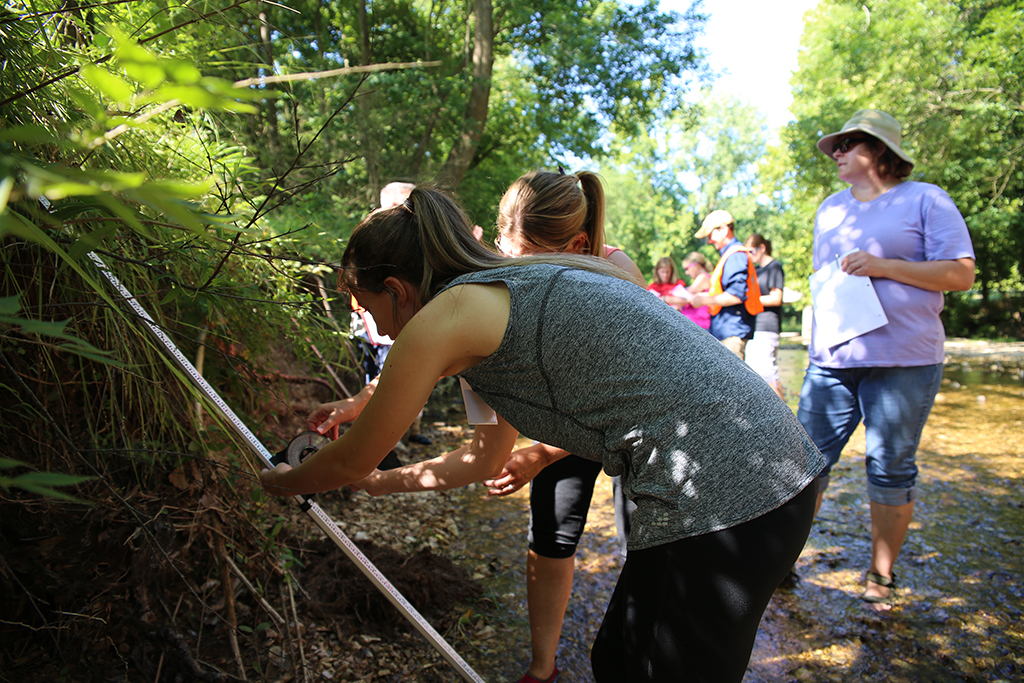
STEM TQ evaluation: Our efforts are moving the academic dial
STEM TQ has graduated more than 8,917 elementary and middle school teachers from almost every district in the Illinois–Missouri bistate region, as well as many charter school teachers. Participants and students are administered pre- and postsurveys to measure their confidence in STEM skills. Results show that 100% of STEM TQ participants are implementing the strategies that they learned in their classroom (see Figures 7 and 8). Our data show that students who learn from STEMpact teachers score higher on standardized math and science tests than their peers, and more importantly, teachers report their students have acquired invaluable critical-thinking and problem-solving skills. Annual evaluations continue to show that students of participating teachers report improved perceptions of themselves as STEM-capable learners (from fall to spring). A district contact person is tasked with providing annual district achievement data to STEMpact personnel. The information collected consists of test scores in mathematics and science from the Missouri Assessment Program (MAP) for grades 3–8. The data are provided by the Missouri Department of Elementary and Secondary Education. The data collected are used to compare the following:
- STEM TQ to non-STEM TQ classroom performance,
- student performance (using student numbers, no names) compared to themselves, and
- grade-level performance
Feedback from and evaluation of the STEM TQ institute are based on qualitative and quantitative data, including:
- Daily Exit Slips: Each day, participants are asked to offer assessment and comments about the sessions of the day, including content, pace, clarity, and any lingering questions.
- Attendance: Daily sign-in sheets and session attendance provide insight into participant choices, in addition to offering accountability for the stipend to be paid.
- STEMitizing Organizers: All (100%) of the Institute participants complete 3 Organizers to prepare for classroom implementation of STEMitized grade-level curriculum.
- 2 Slides, 2 Minutes: In six different grade-level cluster groups, each participant (100%) shares one idea for STEMitizing classroom content by having prepared 2 slides illustrating the STEM ideas they plan to integrate.
- STEM TQ Institute survey: Participants (100%) self-report on their learning, as a result of the Institute, and their ideas for classroom implementations.
After completing the STEM TQ program, one participant said, “We tell our students that we are getting them ready for the real world, but in the educational system we are not exactly in the real world. It’s nice to see and [hear] from these companies what we should be preparing our students for.” Another participant called STEM TQ a game-changer: “I do a lot of PD [professional development], but nothing like this. It has been really involved and hands-on, inquiry-based learning.”
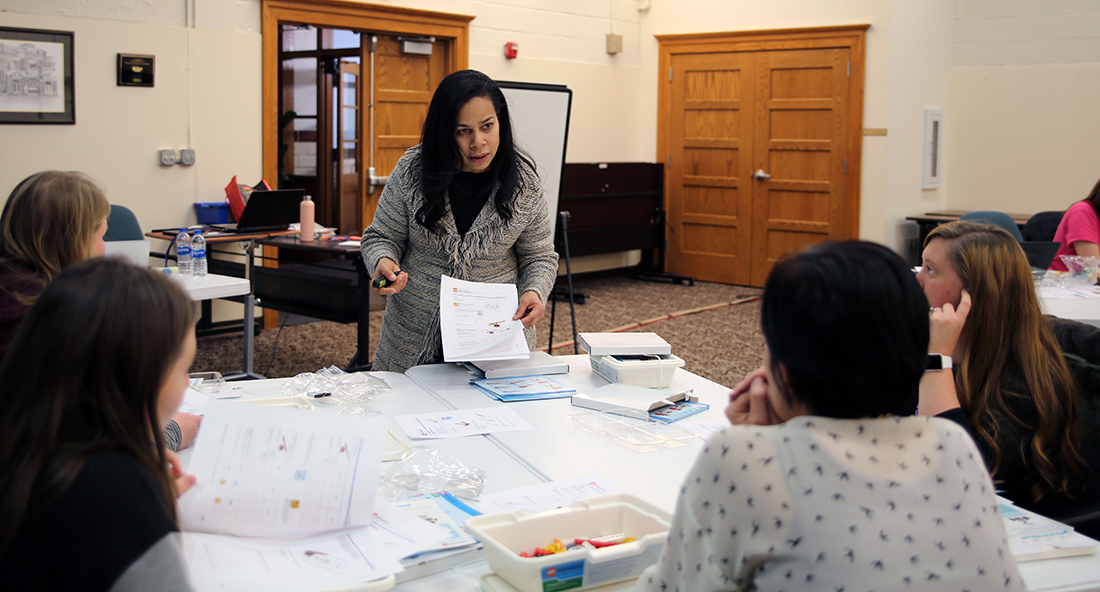
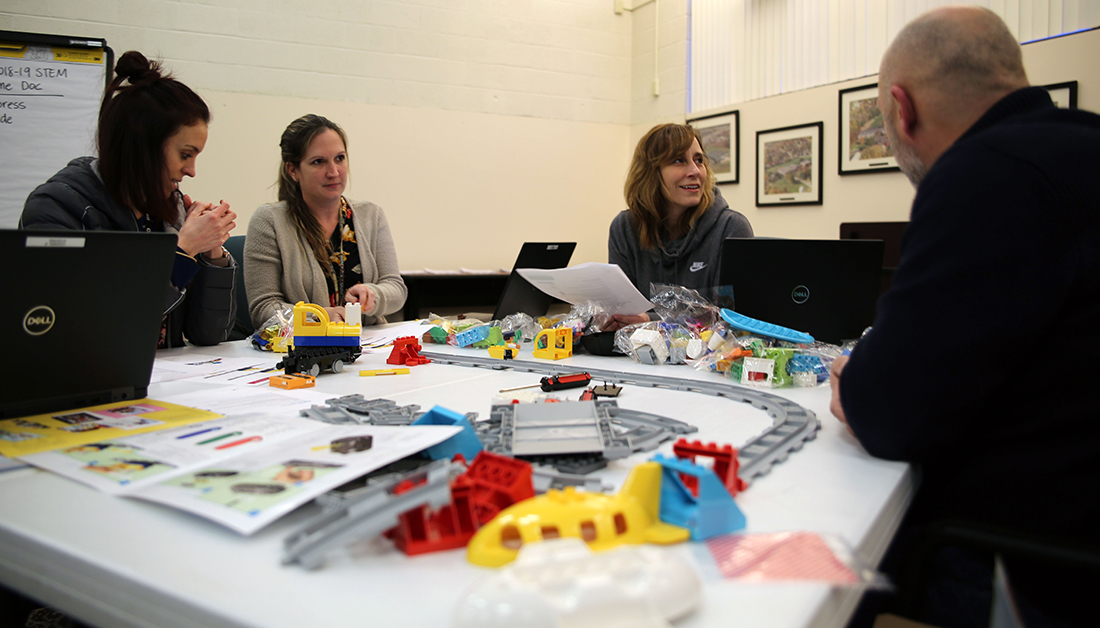
STEM IQ: Developing a schoolwide STEM culture
The STEMpact Integration Quality program was developed with the goal of increasing STEM learning across an entire school district. This matching grant program enables schools whose teachers participated in STEM TQ to share their experience with a wider school community. Participants implement STEM programs unique to their classroom, building, or district. This deep, systematic approach to integrating STEM allows for greater impact than a teacher-by-teacher, single-classroom approach. Districts apply for and develop a three-year implementation plan to strategically impact the STEM opportunities in their school districts, in conjunction with STEMpact facilitators.
Examples of STEM IQ projects include:
- curriculum development for STEM project-based learning,
- creation of district-level professional development/leadership programs,
- a three-year STEM certification program,
- collaborative grade-level projects focused on integrating technology in the classroom, and
- establishment of a STEM Night as an annual community event.
The work done by teachers in the City of St. Charles School District exemplifies the possibilities of STEM IQ to create a large community of STEM-inspired educators. These teachers developed a three-year, multilevel STEM Leadership Academy for teachers from preK to sixth grade. Members meet monthly. At all levels, participants leave each session with classroom takeaways. These vary from LEGO kits to Ozobots to makerspace kits.
At Level 1, participants learn the basics of STEM thinking, talking, and engineering innovation. Level 2 attendees come with STEM knowledge and an eagerness to develop further skills. Each member receives $500 to plan a STEM project for students. Members of Level 3, the top tier, also receive $500 for a project and take part in a capstone project that integrates STEM and is shared with other teachers.
Two years into the leadership academy, the district is pleased with the results. Data show positive impact on student achievement, according to Nicole Adams, an elementary curriculum and instruction specialist, who helped develop the academy.
STEM Leadership Series: Workshops for educators to build skills and confidence
Another STEMpact program is directed toward educators interested in bringing a stronger mindset and intention to community, school, and classroom practices. The STEM Leadership Series is targeted at individuals, educator teams, school leaders, or district administrators interested in strengthening their STEM efforts by learning, sharing, and networking. Through the generous support of STEMpact, WashU’s ISP, and the Missouri Science and Math Coalition, this annual workshop series is provided at no cost and is open to all who are interested in attending. Topics are cultivated from real-world STEM experiences, so participants get current advice and recommendations from the go-to experts in these fields. Recent topics have included STEM best practices and resources, technology integration, 21st-century skills, engineering and design thinking, and problem-solving in math and science.
An assistant principal who attended the leadership series said, “My aha moment was understanding what STEM is about, and how all of the pieces and disciplines work together.” Another participant, an eighth-grade science teacher, described the series as “eye-opening.” He said, “To have the experts, the people that are doing this for a living, saying, ‘This is what is working, and this is where we need to be going’ is very helpful.”
Better together: Shared purpose drives collaboration
What started with a handful of companies has grown to 18 funding members. Every year, STEMpact programs reach at least 450 educators.
What are the essential factors that make this collaboration successful? Identification of shared goals has been critical to making STEMpact’s cross-sector partnerships work. STEMpact was not a solution looking for a problem to solve. It evolved organically, with early conversations focusing on a need for guidance around funding priorities and linking formal and informal STEM education. From those interactions grew a recognition that a collaborative approach would promote systemic change in STEM education across the St. Louis region.
As with any partnership, it starts with building mutual trust and relationships. We began the process by talking about shared goals and leveraged funding to make a difference. We began to move from cooperation to coordination as we designed programs. Through learning together and continuous improvement, we have begun to leverage each other’s strengths and think about the power of collective impact. Each STEMpact partner feels ownership toward STEMpact and continues to grow the program and recruit additional members. The partners recognize the importance of being aligned as opposed to individually highlighted. That collective recognition can be a challenge for some partnerships. However, funders have come to see the alignment of their initiative building into something greater. Funding representatives sit on various committees such as a program committee, communications committee, funding committee, and development committee. Each takes a lead in making the organization work.
Every year, STEMpact members review evaluations and make recommendations for future programming. Each STEMpact program was added based on analysis of need and feedback from participant evaluations.
What makes STEMpact an effective collaboration is that it has broken down historical silos, embraced one strategy to expanding high-quality STEM education, and reduced the replication of funding streams in favor of a long-term, targeted approach. By leveraging partner resources, STEMpact has built a sense of interconnectedness around a unified vision. This infrastructure of informed giving has resulted in funding decisions that are made based on local needs and capacity, and bridge formal and informal learning.
Victoria L. May (vmay@wustl.edu) is executive director of the Institute for School Partnership and assistant dean of arts and sciences at Washington University in St. Louis. Myra Lopez (myralopez@wustl.edu) is communications manager for the Institute for School Partnership at Washington University in St. Louis.



